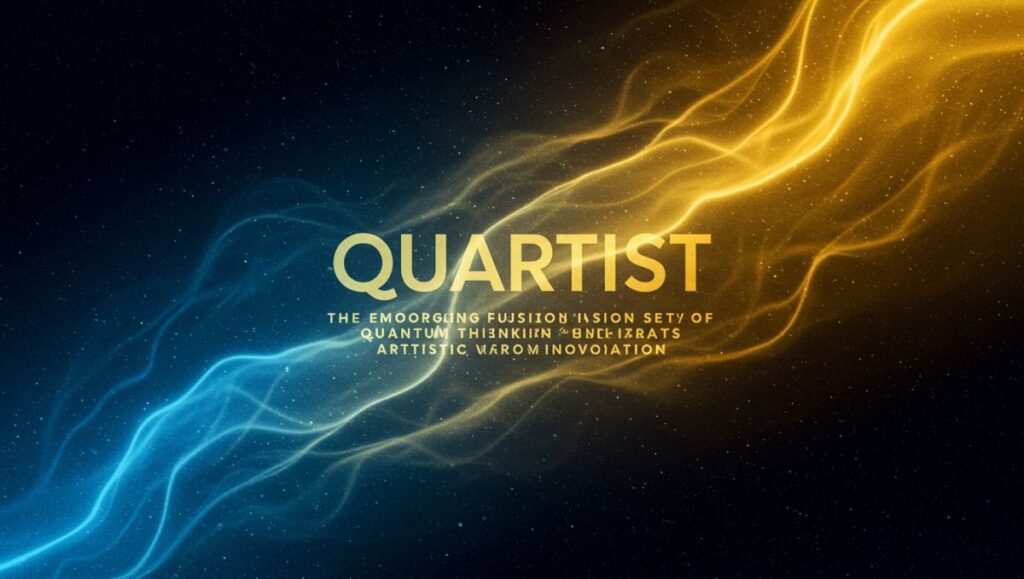As humanity pushes deeper into the realms of quantum physics, digital art, and AI, a new type of creative mind is emerging: the Quartist. This figure is not bound by traditional definitions of artist, scientist, or technologist—instead, the Quartist transcends disciplines, weaving together quantum ideas and creative expression to pioneer novel ways of experiencing reality.
This article explores the meaning, identity, and significance of the Quartist, while examining how they may be influencing the future of technology, art, and human consciousness.
What Is a Quartist?
A Quartist is a hybrid identity—part artist, part scientist, and part philosopher. The term can be seen as a blend of “quantum” and “artist“, suggesting a creator who draws inspiration from quantum mechanics, complexity theory, and nonlinear thinking.
The Quartist might be:
-
A digital artist exploring quantum entanglement through visuals
-
A musician composing soundscapes based on particle physics
-
A coder creating AI-generated art using quantum computing principles
-
A conceptual thinker who sees art as a way to model alternate realities
Rather than working in isolation, the Quartist thrives at the intersections—where science, code, philosophy, and imagination collide.
Origins and Evolution of the Quartist Concept
The term “Quartist” is relatively new and not formally defined in academic literature, but it reflects a cultural and intellectual movement that has been developing over the last two decades.
Influences on the Quartist Identity:
-
Quantum Theory: Ideas like uncertainty, superposition, and entanglement reshape how we understand causality and possibility.
-
Postmodern Art: A rejection of rigid meaning and linear storytelling opens doors for interpretive and interactive works.
-
Digital Tools: Software like TouchDesigner, Processing, and AI models empower artists to build multi-dimensional, real-time installations.
-
Virtual & Augmented Reality: Allow Quartists to build experiential worlds that mimic alternate quantum dimensions.
Core Principles of Quartist Philosophy
While no manifesto formally defines the Quartist, several underlying principles seem to guide this creative archetype:
1. Embracing Uncertainty
Inspired by Heisenberg’s Uncertainty Principle, Quartists accept ambiguity as a space for exploration, not something to be resolved.
2. Multi-Dimensional Creativity
Instead of working in one medium, Quartists may use:
-
Visual art
-
Code
-
Sound
-
Motion
-
Interactive environments
Each dimension adds complexity and resonance.
3. Non-Linearity
A Quartist might create works where there’s no beginning or end, only moments that loop, evolve, and adapt to the viewer’s interaction.
4. Interconnectedness
Similar to quantum entanglement, Quartists explore how everything—ideas, people, systems—is subtly linked, influencing the whole.
5. Observer Influence
In quantum mechanics, the act of observation alters reality. Quartists reflect this by creating works that change based on audience input, gaze, or movement.
Quartist in Practice: Real-World Examples
While few may call themselves “Quartists” directly, many creators embody the concept through their work. Let’s look at examples across domains:
Visual Arts
-
Refik Anadol: Uses quantum computing and AI to generate data-driven art installations that resemble neural networks and quantum fields.
-
Julius Horsthuis: Creates fractal-based VR environments that feel like stepping into a quantum dreamscape.
Music
-
Composers use algorithmic or generative music techniques, where sound evolves in real time based on mathematical or particle behavior models.
-
Musicians are using quantum random number generators to shape compositions.
Philosophy & Writing
-
Writers exploring quantum fiction—stories that shift timelines, blend multiverses, and feature characters aware of their quantum selves.
-
Thinkers who reimagine consciousness using quantum cognition theories.
Tech and Code
-
Programmers developing quantum algorithms to create evolving artworks
-
Artists using Qiskit (IBM’s quantum framework) to produce unpredictable visual outputs
Philosophical Implications of Being a Quartist
A Quartist doesn’t just create—they challenge the very nature of reality and perception.
Reality as Construct
Quartists often approach reality as fluid and malleable—a simulation, projection, or emergent field, much like quantum fields in physics.
Self as Observer
The self is not fixed. Just as particles exist in multiple states, Quartists may explore fluid identity, multiplicity of selves, and the observer effect.
Timelessness
Linear time may be deconstructed, with pieces that evolve forward, backward, or simultaneously, echoing superposition and quantum time loops.
Challenges Quartists Face
While the concept is thrilling, being a Quartist isn’t easy.
Lack of Recognition
Because the identity doesn’t fit existing art or science boxes, Quartists may struggle for funding, platforming, or institutional support.
Technical Barriers
Quantum tools are not yet accessible to the average artist, requiring partnerships with researchers or tech firms.
Audience Readiness
Viewers often expect clear narratives or static art; interactive, evolving, or abstract work can be misunderstood or undervalued.
Mental Load
Working at the edge of philosophy, science, and creativity can lead to burnout or conceptual overwhelm.
The Future of the Quartist Movement
With quantum computing on the rise, AI becoming more collaborative, and virtual environments becoming increasingly common, the Quartist archetype will likely gain relevance.
Future Possibilities:
-
Quartist Collectives is building shared metaverse spaces based on quantum principles
-
Quantum-inspired education models merging art and science from a young age
-
Hybrid jobs like “Quantum Experience Designer” or “AI-Empowered Creative Synthesist”
-
Decentralized Quartist networks sharing tools, code, and cross-disciplinary ideas
As society seeks new ways to make sense of an uncertain, accelerating world, the Quartist offers an inspiring blueprint—not just for what we can create, but how we can think, feel, and connect.
Conclusion
The Quartist represents a new frontier in human creativity—one where science and art no longer compete but collaborate. They are explorers of uncertainty, builders of immersive realities, and philosophers of quantum existence.
In blending disciplines once thought separate, Quartists challenge the rules of perception, time, and truth. Their work doesn’t just entertain—it awakens. It teaches us that we are not linear beings in a static universe—we are dynamic observers in an entangled, ever-shifting multiverse.
Whether you’re an artist, scientist, coder, or curious thinker, embracing the Quartist mindset may open new doors—to yourself, your work, and the infinite possibilities of reality itself.







